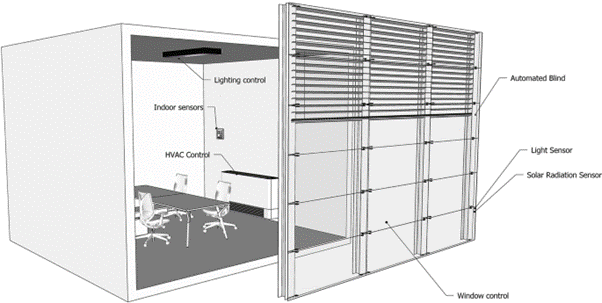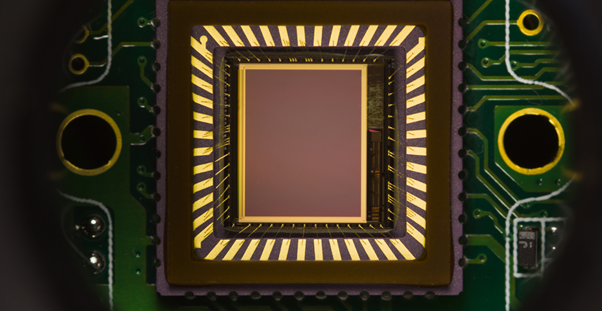By Antonia Egli, Luiz Evelin, and Prof Theo Lynn (Dublin City University)
The RINNO blog series on the recently published open access book ‘Disrupting Buildings: Digitalisation and the Transformation of Deep Renovation’ continues this week with a spotlight on Chapter 2: Embedded Sensors, Ubiquitous Connectivity and Tracking. Today, we focus on Dr. Marco Arnesano and Silvia Angela Mansi’s chapter on how computation capabilities are integrated into the physical environment and the role of sensor networks in the context of deep renovation. For timely updates on this blog series, sign up to the RINNO newsletter or follow us on social media here.
Sustainability and energy efficiency goals in the construction and renovation industries have led to a growing reliance on sensors and the Internet of Things (IoT). These technologies are transforming buildings into smart, environmentally friendly structures that offer comfort and efficiency to their occupants. Sensors play a pivotal role in construction, renovation, and the operation of smart buildings, and are accompanied by an array of diverse benefits and challenges.
What is the role of sensors in construction and renovation?
In the worlds of construction and renovation, effective monitoring and data collection are paramount. Traditional methods of on-site visits and manual documentation are today being replaced by cutting-edge sensor technology and IoT – a network of interconnected physical objects and devices that are embedded with sensors and software, which allows them to collect and exchange data with each other and central systems. These advances are radically changing how we manage construction sites, making the process more efficient and precise.
With IoT, construction and renovation activities can be monitored automatically and in real-time. This provides infrastructure for seamless communication in multi-stakeholder projects. At the same time, the use of sensors allows for a better understanding of the status of different construction activities, thus improving productivity and saving both time and cost.
Different approaches can be applied to the real-time monitoring of construction processes to provide an understanding of the scene and support positioning and tracking. These include:
- Classification: A process to assign a label to the scene based on a supervised machine learning (SML) algorithm (Maturana & Scherer, 2015)
- Object detection: A process to localise objects of a specific category of data (He et al., 2017)
- Segmentation: A method to divide data into segments representing objects (Chen et al., 2018)
- Proximity: A method to detect mobile targets by using location coordinates of nearby sensors with a priorly measured position (Deak et al., 2012)
- Triangulation and trilateration: Methods to estimate the target position using triangles’ properties (Deak et al., 2012)
- Fingerprinting: Uses a database of signals measured at known locations to estimate an object’s location by comparing the current signal with the stored signals
- Dead reckoning: A method to estimate the local motion of a moving target relative to a previously known position
- Visual positioning: Estimates the position and orientation of sensors by using imagery and point clouds data (Zhang & Singh, 2015)
- Active tracking: Tracks moving objects using different position methods (Deak et al., 2012)
- Passive tracking: Involves surveying instruments such as robotic stations, stationary cameras or lidar sensors (Giancola et al., 2019)
One of the key technologies at the forefront of construction site monitoring is 3D point cloud data. This approach creates a digital twin of a building, allowing for real-time mapping and tracking of objects on-site. Digital twins are virtual representations of physical objects, systems, or processes that provide real-time, dynamic insights and analysis to improve understanding, decision-making, and performance. By integrating data from various sensors, the quality and accuracy of information acquired by each sensor can be significantly improved.
Positioning sensors are crucial for measuring the distance travelled by a body starting from its reference position, while communication sensors facilitate the exchange of data between different devices. For example, communication sensors, when integrated with positioning and mapping sensors, can be employed to enhance the outdoor tracking of resources in a supply chain management system and improve construction safety management.
What are smart buildings and smart homes?
The concept of smart buildings goes beyond construction sites and extends into building operation. A smart building is an intelligent structure that aims to achieve the optimal balance between overall comfort and energy consumption. It accomplishes this by utilising intelligent computer technologies. The result is a building that can adapt its operation and physical form to specific events before they even occur (Buckman et al., 2014) while maintaining energy efficiency and occupant satisfaction.
[…] buildings should become a system that “provides every occupant with productive, cost effective and environmentally approved conditions through continuous interaction among its elements.”
Buckman et al., 2014, p. 96
The concept of a smart home is essentially the residential counterpart of a smart building. Smarte homes are environments equipped with technologies that make the lives of occupants more convenient while preserving energy efficiency. Smart appliances can cover different aspects of daily life, including air conditioning, lighting, home security, data privacy, entertainment, surveillance, detection, and assisting living (Wilson et al., 2015).
In the context of smart buildings and smart homes, sensors play a pivotal role due to the need for measuring various quantities across different domains. Electricity and heat metres are essential for energy monitoring, while environmental sensors for temperature, relative humidity, light, and CO2 levels are crucial for measuring and controlling occupants’ comfort.
What benefits does IoT bring to smart buildings and smart homes?
The backbone of IoT is its architectural framework, which allows everyday objects to become intelligent and interconnected through sensing, networking, and processing capabilities. IoT architectures are typically divided into three layers: Perception, Network, and Application.

The three layers of IoT architecture
The Perception layer serves as the physical layer equipped with sensors for data collection. These sensors detect environmental parameters and identify other intelligent sensors in the physical space to share information. The Network layer is responsible for processing and transmitting the raw data using network technologies. Finally, the Application layer bridges the gap between the building and the end user, supporting the decision-making process.
IoT architectures rely on messaging and connectivity protocols for the exchange of information from remote locations. The recommended features of such protocols include small code footprints, low power consumption, minimal bandwidth consumption, low latency, and the use of a publish/subscribe (pub/sub) pattern. The most widely used messaging protocol is the Message Queuing Telemetry Transport (MQTT), known for its lightweight nature, small footprint, and minimal bandwidth consumption (Spofford, 2019).
What is continuous monitoring in construction and renovation?
Continuous monitoring is vital for efficiency in construction. Sensors, when integrated with Building Information Modeling (BIM), enable the real-time tracking of construction progress. This results in improved cost control, better quality management, and proactive issue identification. By combining sensor data with BIM, a real-time digital twin of the construction process is created. This digital twin can continuously track changes and discrepancies during construction, enabling timely error correction and monitoring of material conditions on-site.
BIM-sensor integration plays a key role in preventive monitoring during the construction phase. This integration allows for the monitoring and assurance of proper structure conditions. IoT technologies are employed proactively to predict building component failures, unplanned downtime, and broken tools, potentially increasing on-site productivity by up to 25%. For the automatic retrieval of physical information during the construction process, Radio-Frequency Identification (RFID) has been widely adopted. BIM augmented with sensor data is also crucial for facility management, as the total cost of ownership of a building heavily depends on effective maintenance and the safety of the environment for occupants.
Sensing During Building Operation
Heating, ventilation, and air conditioning (HVAC) systems are responsible for approximately 40% of a building’s energy consumption. Optimising these systems is crucial for smart building energy management. Recent developments in affordable Indoor Environmental Quality (IEQ) sensors have also enabled the continuous monitoring of indoor climate conditions, which can significantly impact building performance. IEQ sensors measure air temperature, humidity, carbon dioxide (CO2) levels, particulate matter (PM), air pollutants, illuminance, and noise. These sensors provide insights into building performance and enable the detection of building pathologies. By using non-intrusive IoT systems for IEQ monitoring, building issues can be identified, paving the way for better performance post-renovation in terms of thermal comfort and indoor air quality. The application of IEQ monitoring is also facilitated in existing buildings by integrating sensors with plug-and-play façade modules for deep renovation. This approach ensures that indoor environmental quality is optimised while reducing costs and time during the renovation process.

Concept of the IoT façade module
Challenges and Concerns of Sensor Technologies in Deep Renovation: Data Management and Ethics
The vast amount of data generated by sensors poses significant data management challenges. Cloud computing is the primary method used for sensor data management. However, this approach raises concerns about data jurisdiction, service-level agreements (SLAs), and acceptable use policies (AUPs). Data protection regulations such as the European Union’s General Data Protection Regulation (GDPR) come into play, necessitating careful consideration of data handling.
The implementation of sensor technologies also brings human and ethical concerns to the forefront. In smart homes and workplaces, sensor data can potentially compromise privacy and security. For example, data from IEQ sensors could provide information on the occupancy of a workplace or a smart home. Regarding security, sensor data must be legally protected in case of malicious or unintentional data exposure.
In conclusion, the use of sensors and IoT technologies is reshaping the construction and operation of buildings, from construction sites to deep renovations and smart buildings. These technologies offer immense potential for energy efficiency, cost savings, and improved occupant comfort. However, the handling of sensor data also raises concerns, both in terms of data privacy and ethical considerations. A balanced approach, considering both the advantages and challenges, is crucial for realising the full potential of sensor networks in the built environment.
To download the full open access book, ‘Disrupting Buildings,’ click here.
References
Buckman, A. H., Mayfield, M., & Beck, S. B. M. (2014). What is a smart building? Smart and Sustainable Built Environment, 3(2), 92–109. https://doi.org/10.1108/SASBE-01-2014-0003
Chen, L. C., Papandreou, G., Kokkinos, I., Murphy, K., & Yuille, A. L. (2018). DeepLab: Semantic image segmentation with deep convolutional nets, atrous convolution, and fully connected CRFs. IEEE Transactions on Pattern Analysis and Machine Intelligence, 40(4), 834–848. https://doi.org/10.1109/TPAMI.2017.2699184
Deak, G., Curran, K., & Condell, J. (2012). A survey of active and passive indoor localisation systems. Computer Communications, 35(16), 1939–1954. https://doi.org/10.1016/J.COMCOM.2012.06.004
Giancola, S., Zarzar, J., & Ghanem, B. (2019). Leveraging shape completion for 3D Siamese tracking. In Proceedings of the IEEE Computer Society Conference on Computer Vision and Pattern Recognition, 2019-June (pp. 1359–1368). IEEE. https://doi.org/10.1109/CVPR.2019.00145
He, K., Gkioxari, G., Dollar, P., & Girshick, R. (2017). Mask R-CNN. In Proceedings of the IEEE International Conference on Computer Vision, 2017-October (pp. 2980–2988). IEEE. https://doi.org/10.1109/ICCV.2017.322
Maturana, D., & Scherer, S. (2015). VoxNet: A 3D Convolutional Neural Network for real-time object recognition. In IEEE International Conference on Intelligent Robots and Systems, 2015-December (pp. 922–928). IEEE. https://doi.org/10.1109/IROS.2015.7353481
Spofford, D. (2019). What is MQTT in IoT? Retrieved June 6, 2022, from https://www.verypossible.com/insights/what-is-mqtt-in-iot
Wilson, C., Hargreaves, T., & Hauxwell-Baldwin, R. (2015). Smart homes and their users: A systematic analysis and key challenges. Personal and Ubiquitous Computing, 19(2), 463–476. https://doi.org/10.1007/S00779-014-0813-0
Zhang, J., & Singh, S. (2015). LOAM: Lidar odometry and mapping in real-time. https://doi.org/10.15607/RSS.2014.X.007


 This project has received funding from the European Union's Horizon 2020 research and innovation programme under grant agreement No 892071.
This project has received funding from the European Union's Horizon 2020 research and innovation programme under grant agreement No 892071.